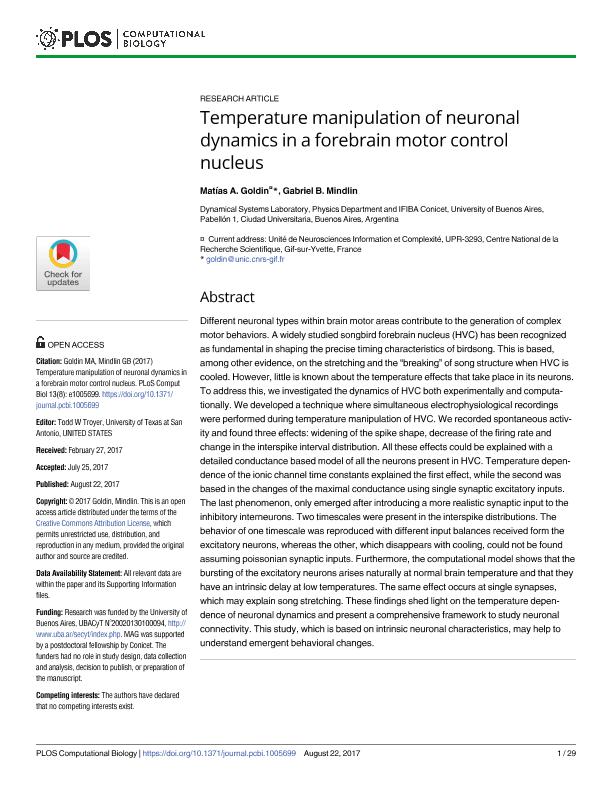Mostrar el registro sencillo del ítem
dc.contributor.author
Goldin, Matías Alejandro

dc.contributor.author
Mindlin, Bernardo Gabriel

dc.date.available
2018-07-24T20:05:39Z
dc.date.issued
2017-08
dc.identifier.citation
Goldin, Matías Alejandro; Mindlin, Bernardo Gabriel; Temperature manipulation of neuronal dynamics in a forebrain motor control nucleus; Public Library of Science; PLoS Biology; 13; 8; 8-2017; 1-29
dc.identifier.issn
1544-9173
dc.identifier.uri
http://hdl.handle.net/11336/53018
dc.description.abstract
Different neuronal types within brain motor areas contribute to the generation of complex motor behaviors. A widely studied songbird forebrain nucleus (HVC) has been recognized as fundamental in shaping the precise timing characteristics of birdsong. This is based, among other evidence, on the stretching and the "breaking" of song structure when HVC is cooled. However, little is known about the temperature effects that take place in its neurons. To address this, we investigated the dynamics of HVC both experimentally and computationally. We developed a technique where simultaneous electrophysiological recordings were performed during temperature manipulation of HVC. We recorded spontaneous activity and found three effects: widening of the spike shape, decrease of the firing rate and change in the interspike interval distribution. All these effects could be explained with a detailed conductance based model of all the neurons present in HVC. Temperature dependence of the ionic channel time constants explained the first effect, while the second was based in the changes of the maximal conductance using single synaptic excitatory inputs. The last phenomenon, only emerged after introducing a more realistic synaptic input to the inhibitory interneurons. Two timescales were present in the interspike distributions. The behavior of one timescale was reproduced with different input balances received form the excitatory neurons, whereas the other, which disappears with cooling, could not be found assuming poissonian synaptic inputs. Furthermore, the computational model shows that the bursting of the excitatory neurons arises naturally at normal brain temperature and that they have an intrinsic delay at low temperatures. The same effect occurs at single synapses, which may explain song stretching. These findings shed light on the temperature dependence of neuronal dynamics and present a comprehensive framework to study neuronal connectivity. This study, which is based on intrinsic neuronal characteristics, may help to understand emergent behavioral changes.
dc.format
application/pdf
dc.language.iso
eng
dc.publisher
Public Library of Science

dc.rights
info:eu-repo/semantics/openAccess
dc.rights.uri
https://creativecommons.org/licenses/by-nc-sa/2.5/ar/
dc.subject
Birdsong
dc.subject
Neuroscience
dc.subject
Rhythms
dc.subject.classification
Astronomía

dc.subject.classification
Ciencias Físicas

dc.subject.classification
CIENCIAS NATURALES Y EXACTAS

dc.title
Temperature manipulation of neuronal dynamics in a forebrain motor control nucleus
dc.type
info:eu-repo/semantics/article
dc.type
info:ar-repo/semantics/artículo
dc.type
info:eu-repo/semantics/publishedVersion
dc.date.updated
2018-07-23T18:31:41Z
dc.identifier.eissn
1545-7885
dc.journal.volume
13
dc.journal.number
8
dc.journal.pagination
1-29
dc.journal.pais
Estados Unidos

dc.journal.ciudad
San Francisco
dc.description.fil
Fil: Goldin, Matías Alejandro. Consejo Nacional de Investigaciones Científicas y Técnicas. Oficina de Coordinación Administrativa Ciudad Universitaria. Instituto de Física de Buenos Aires. Universidad de Buenos Aires. Facultad de Ciencias Exactas y Naturales. Instituto de Física de Buenos Aires; Argentina. Centre National de la Recherche Scientifique; Francia
dc.description.fil
Fil: Mindlin, Bernardo Gabriel. Consejo Nacional de Investigaciones Científicas y Técnicas. Oficina de Coordinación Administrativa Ciudad Universitaria. Instituto de Física de Buenos Aires. Universidad de Buenos Aires. Facultad de Ciencias Exactas y Naturales. Instituto de Física de Buenos Aires; Argentina
dc.journal.title
PLoS Biology

dc.relation.alternativeid
info:eu-repo/semantics/altIdentifier/doi/http://dx.doi.org/10.1371/journal.pcbi.1005699
dc.relation.alternativeid
info:eu-repo/semantics/altIdentifier/url/http://journals.plos.org/ploscompbiol/article?id=10.1371/journal.pcbi.1005699
Archivos asociados
